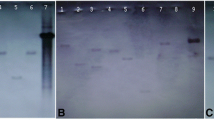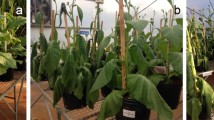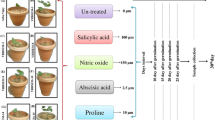Abstract
Upregulation of the antioxidant enzyme system in plants provides protection against various abiotic stresses. Transgenic potato plants overexpressing the strawberry d-galacturonic acid reductase (GalUR) gene with enhanced accumulation of ascorbate (AsA) were used to study the antioxidant system involving the ascorbate–glutathione cycle in order to understand the tolerance mechanism in plants in response to various abiotic stresses under in vitro conditions. Transgenic potato tubers subjected to various abiotic stresses induced by methyl viologen, sodium chloride and zinc chloride showed enhanced activities of superoxide dismutase (SOD, EC 1.15.1.1), catalase (CAT, EC 1.1.1.1.6) and enzymes of the ascorbate–glutathione cycle such as ascorbate peroxidase (APX, EC 1.11.1.11), dehydroascorbate reductase (DHAR, EC 1.8.5.1) and glutathione reductase (GR, EC 1.8.1.7), as well as increased levels of ascorbate, glutathione (GSH) and proline when compared to untransformed tubers. The increased enzyme activities correlated with the mRNA transcript levels in the stressed transgenic tubers. Significant differences in redox status of AsA and GSH were also observed in stressed transgenic potato tubers that showed increased tolerance to abiotic stresses compared to untransformed tubers. This study suggests that the increased accumulation of AsA could upregulate the antioxidant system which imparts improved tolerance against various abiotic stresses in transgenic tubers compared to untransformed tubers.




Similar content being viewed by others
Abbreviations
- APX:
-
Ascorbate peroxidase
- CAT:
-
Catalase
- DHAR:
-
Dehydroascorbate reductase
- GalUR:
-
d-galacturonic acid reductase
- GR:
-
Glutathione reductase
- GSH:
-
Reduced glutathione
- GSSG:
-
Oxidized glutathione
- MDA:
-
Malondialdehyde
- MDHAR:
-
Monodehydroascorbate reductase
- MV:
-
Methyl viologen
- ROS:
-
Reactive oxygen species
- SOD:
-
Superoxide dismutase
- ZnCl:
-
Zinc chloride
References
Aebi H (1984) Catalase in vitro. Methods Enzymol 105:21–126
Allen RD, Webb RP, Schake SA (1997) Use of transgenic plants to study antioxidant defenses. Free Radicals BioMed 23:473–479
Alscher RG, Donahue JL, Crammer CL (1997) Reactive oxygen species and antioxidants: relationship in green cells. Plant Physiol 100:224–233
Aono M, Saji H, Sakamoto A, Tanaka K, Kondo N (1995) Paraquat tolerance of transgenic Nicotiana tabacum with enhanced activities of glutathione reductase and superoxide dismutase. Plant Cell Physiol 36:1687–1691
Apel K, Hirt H (2004) Reactive oxygen species: metabolism, oxidative stress, and signal transduction. Annu Rev Plant Biol 55:373–399
Asada K (1999) The water-water cycle in chloroplasts: scavenging of active oxygens and dissipation of excess photons. Ann Rev Plant Physiol Plant Mol Biol 50:601–639
Barth C, Moeder W, Klessig DF, Conklin PL (2004) The timing of senescence and response to pathogens is altered in the ascorbate deficient Arabidopsis mutant vitamin c-1. Plant Physiol 134:1784–1792
Bartoli CG, Yu JP, Gómez F, Fernández L, McIntosh L, Foyer CH (2006) Inter-relationships between light and respiration in the control of ascorbic acid synthesis and accumulation in Arabidopsis thaliana leaves. J Exp Bot 57:1621–1631
Bates LE, Waldren RP, Teare ID (1973) Rapid determination of free proline for water stress studies. Plant Soil 39:205–207
Benavides MP, Marconi PL, Gallego SM, Comba ME, Tomaro ML (2000) Relationship between antioxidant defence systems and salt tolerance in Solanum tuberosum. Aust J Plant Physiol 27:273–278
Bradford MM (1976) A rapid and sensitive method for the quantitation of microgram quantities of protein utilizing the principle of protein-dye binding. Ann Biochem 72:248–254
Burkey KO, Eason G (2002) Ozone tolerance in snap bean is associated with elevated ascorbic acid in the leaf apoplast. Physiol Plant 114:387–394
Cao YJ, Wei Q, Liao Y, Song HL, Li X, Xiang CB, Kuai BK (2009) Ectopic overexpression of AtHDG11 in tall fescue resulted in enhanced tolerance to drought and salt stress. Plant Cell Rep 28:579–588
Chen Z, Gallie DR (2005) Increasing tolerance to ozone by elevating foliar ascorbic acid confers greater protection against ozone than increasing avoidance. Plant Physiol 138:1673–1689
Chen Z, Todd E, Ling YJ, Chang SC, Gallie DR (2003) Increasing vitamin C content of plants through enhanced ascorbate recycling. Proc Natl Acad Sci USA 100:3525–3530
Conklin PL, Barth C (2004) Ascorbic acid, a familiar small molecule intertwined in the response of plants to ozone, pathogens, and the onset of senescence. Plant Cell Environ 27:959–970
Conklin PL, Williams EH, Last RL (1996) Environmental stress sensitivity of an ascorbic acid-deficient Arabidopsis mutant. Proc Natl Acad Sci USA 3:9970–9974
del Rio LA, Corpas FJ, Sandalio LM, Palme JM, Gómez M, Barroso JB (2002) Reactive oxygen species, antioxidant systems and nitric oxide in peroxisomes. J Exp Bot 53:1255–1272
Demmig-Adams B (1990) Carotenoids and photoprotection: a role for the xanthophylls zeaxanthin. Biochim Biophys Acta 1020:1–24
Demmig-Adams B, Adams WW III (1992) Photoprotection and other responses to high light stress. Annu Rev Plant Physiol Plant Mol Biol 43:599–626
Eskling M, Arvidsson PO, Akerlund HE (1997) The xanthophyll cycle, its regulation and components. Physiol Plant 100:806–816
Finazzi-Agro A, Di Giulio A, Amicosante G, Crifo C (1986) Photohemolysis of erythrocytes enriched with superoxide dismutase, catalase, and glutathione peroxidae. Photochem Photobiol 43:409–412
Foyer CH, Halliwell B (1976) The presence of glutathione and glutathione reductase in chloroplasts: a proposed role in ascorbic acid metabolism. Planta 133:21–25
Foyer CH, Lelandais M (1996) A comparison of the relative rates of transport of ascorbate and glucose across the thylakoid, chloroplast and plasmalemma membranes of pea leaf mesophyll cells. J Plant Physiol 148:391–398
Foyer CH, Noctor G (2003) Redox sensing and signalling associated with reactive oxygen in chloroplasts, peroxisome and mitochondria. Physiol Plant 119:355–364
Foyer C, Lelandais M, Galap C, Kunert KJ (1991) Effect of elevated cytosolic glutathione reductase activity on the cellular glutathione pool and photosynthesis in leaves under normal and stress conditions. Plant Physiol 97:863–872
Foyer CH, Souriau N, Perret S, Lelandais M, Kunert KJ, Pruvost C (1995) Overexpression of glutathione reductase but not glutathione synthetase leads to increases in antioxidant capacity and resistance in photoinhibition in poplar trees. Plant Physiol 109:1047–1057
Freebairn HT, Taylor OC (1960) Prevention of plant damage from airborne oxidising agents. Proc Am Soc Hort Sci 76:693–699
Fujita M, Fujita Y, Noutoshi Y, Takahashi F, Narusaka Y, Yamaguchi-Shinozaki K, Shinozaki K (2006) Crosstalk between abiotic and biotic stress responses: a current view from the points of convergence in the stress signaling networks. Curr Opin Plant Biol 9:436–442
Griffith OW (1980) Determination of glutathione and glutathione disulfide using glutathione reductase and 2-vinylpyridine. Ann Biochem 106:207–212
Heath RL, Packer L (1968) Photoperoxidation in isolated chloroplasts. I. Kinetics and stoichiometry of fatty acid peroxidation. Arch Biochem Biophys 125:189–198
Hemavathi, Upadhyaya CP, Ko EY, Nookaraju A, Kim HS, Heung JJ, Oh MO, Reddy AC, Chun SC, Kim DH, Park SW (2009) Over-expression of strawberry D-galacturonic acid reductase in potato leads to accumulation of vitamin C with enhanced abiotic stress tolerance. Plant Sci 177:659–667
Inzé D, Van Montagu M (1995) Oxidative stress in plants. Curr Opin Biotechnol 6:153–158
Jimenez A, Hernandez JA, del Rio LA, Sevilla F (1997) Evidence for the presence of the ascorbate-glutathione cycle in mitochondria and peroxisomes of pea leaves. Plant Physiol 114:275–284
Kampfenkel K, Van Montagu M, Inze D (1995) Effect of iron excess on Nicotiana plumbaginifolia plants. Implications to oxidative stress. Plant Physiol 107:725–735
Kwon SY, Jeong YJ, Lee HS, Kim JS, Cho KY, Allen RD (2002) Enhanced tolerance of transgenic tobacco plants expressing both superoxide dismutase and ascorbate peroxidase in chloroplasts against methyl viologen mediated oxidative stress. Plant Cell Environ 25:873–882
Kwon SY, Choi SM, Ahn YO, Lee HS, Lee HB, Park YM, Kwak SS (2003) Enhanced stress-tolerance of transgenic plants expressing a human dehydroascorbate reductase gene. J Plant Physiol 160:347–353
Larkindale J, Mishkind M, Vierling E (2005) Plant responses to high temperature. In: Jenks MA, Hasegawa PM (eds) Plant abiotic stress. Blackwell Scientific Publications, Oxford
Lee EH (1991) Plant resistance mechanisms to air pollutants: rhythms in ascorbic acid production during growth under ozone stress. Chronobiol Int 8:93–102
Lee EH, Jersey JA, Gifford C, Bennett J (1984) Differential ozone tolerance in soybean and snapbeans: analysis of ascorbic acid in O3-susceptible and O3-resistant cultivars by high performance liquid chromatography. Environ Exp Bot 24:331–341
Lee YP, Kim SH, Bang JW, Lee HS, Kwak SS, Kwon SY (2007) Enhanced tolerance to oxidative stress in transgenic tobacco plants expressing three antioxidant enzymes in chloroplasts. Plant Cell Rep 26:591–598
Levine A, Tenhaken R, Dixon R, Lamb C (1994) H2O2 from the oxidative burst orchestrates the plant hypersensitive disease resistance response. Cell 79:583–593
Loewus FA (1999) Biosynthesis and metabolism of ascorbic acid in plants and of analogs of ascorbic acid in fungi. Phytochemistry 52:193–210
Ma FW, Cheng LL (2004) Exposure of the shaded side of apple fruit to full sun leads to upregulation of both xanthophyll cycle and the ascorbate-glutathione cycle. Plant Sci 166:1479–1486
May M, Leaver CJ (1993) Oxidative stimulation of glutathione synthesis in Arabidopsis thaliana suspension-cultures. Plant Physiol 103:621–627
McKersie BD, Bowley SR, Jones KS (1999) Winter survival of transgenic alfalfa overexpressing superoxide dismutase. Plant Physiol 119:839–847
Mora-Herrera ME, Lopez-Delgado HA (2007) Freezing tolerance and antioxidant activity in potato microplants induced by abscisic acid treatment. Am J Potato Res 84:467–475
Murashige T, Skoog F (1962) A revised medium for rapid growth and bioassays with tobacco tissue cultures. Physiol Plant 15:473–497
Nakano Y, Asada K (1981) Hydrogen peroxide is scavenged by ascorbate-specific peroxidase in spinach chloroplasts. Plant Cell Physiol 22:867–880
Navari-Izzo F, Rascio N (1999) Plant response to water-deficit conditions. In: Pessarakli M (ed) Handbook of plant and crop stress. Marcel Dekker Inc, New York, pp 231–270
Niyogi KK (1999) Photoprotection revisited: genetic and molecular approaches. Annu Rev Plant Physiol Plant Mol Biol 50:333–359
Noctor G, Foyer CH (1998) Ascorbate and glutathione: keeping active oxygen under control. Annu Rev Plant Physiol Plant Mol Biol 49:249–279
Paoletti F, Aldinucci D, Mocali A, Caparrini A (1986) A sensitive spectrometric method for the determination of superoxide dismutase activity in tissue extracts. Ann Biochem 54:536–541
Pavet V, Olmos E, Kiddle G, Mowla S, Kumar S, Antoniw J, Alvarez ME, Foyer CH (2005) Ascorbic acid deficiency activates cell death and disease resistance responses in Arabidopsis. Plant Physiol 139:1291–1303
Payton P, Allen RD, Trolinder N, Holaday AS (1997) Over-expression of chloroplast-targeted Mn superoxide dismutase in cotton (Gossypium hirsutum L., cv. Coker 312) does not alter the reduction of photosynthesis after short exposures to low temperature and high light intensity. Photosyn Res 52:233–244
Polle A (2001) Dissecting the superoxide dismutase-ascorbate-glutathione pathway in chloroplasts by metabolic modeling. Computer simulations as a step towards flux analysis. Plant Physiol 126:445–462
Rahnama H, Ebrahimzadeh H (2005) The effect of NaCl on antioxidant enzyme activities in potato seedling. Biol Planta 49:93–97
Rautenkranz AAF, Li L, Michler F, Mgxtinoia E, Oertli JJ (1994) Transport of ascorbic and dehydroascorbic acids across protoplast and vacuole membranes isolated from barley (Hordeum vulgate L. cv Gerbel) leaves. Plant Physiol 106:187–193
Sanmartin M, Drogoudi PA, Lyons T, Pateraki I, Barnes J, Kanellis AK (2003) Over-expression of ascorbate oxidase in the apoplast of transgenic tobacco results in altered ascorbate and glutathione redox states and increased sensitivity to ozone. Planta 216:918–928
Scott MD, Meshnick SR, Eaton JW (1987) Superoxide dismutase-rich bacteria. Paradoxical increase in oxidant toxicity. J Biol Chem 262:3640–3645
Sen-Gupta A, Heinen J, Holaday AS, Burke JJ, Allen RD (1993) Increased resistance to oxidative stress in transgenic plants that over-express chloroplastic Cu/Zn superoxide dismutase. Proc Natl Acad Sci USA 90:1629–1633
Shalata A, Neumann PM (2001) Exogenous ascorbic acid (vitamin C) increases resistance to salt stress and reduces lipid peroxidation. J Exp Bot 52:2207–2211
Shalata A, Mittova V, Volokita M, Guy M, Tal M (2001) Response of the cultivated tomato and its wild salt-tolerant relative Lycopersicon pennellii to salt-dependent oxidative stress: the root antioxidative system. Physiol Plant 112:487–494
Shigeoka S, Ishikawa T, Tamoi M, Miyagawa Y, Takeda T, Yabuta Y, Yoshimura K (2002) Regulation and functions of ascorbate peroxidase isoenzymes. J Exp Bot 53:1305–1311
Smirnoff N (1993) The role of active oxygen in the response of plants to water deficit and desiccation. New Phytol 125:27–58
Smirnoff N (1996) The function and metabolism of ascorbic acid in plants. Ann Bot 78:661–669
Smirnoff N (2005) Ascorbate, tocopherol and carotenoids: metabolism, pathway engineering and functions. In: Smirnoff N (ed) Antioxidants and reactive oxygen species in plants. Blackwell Publishing Ltd, Oxford, pp 53–86
Smirnoff N, Wheeler GL (2000) Ascorbic acid in plants: biosynthesis and function. Crit Rev Plant Sci 19:267–290
Thomas CE, McLean LR, Parker RA, Ohlweiler DF (1992) Ascorbate and phenolic antioxidant interactions in prevention of liposomal oxidation. Lipids 27:543–550
Tokunaga T, Miyahara K, Tabata K, Esaka M (2005) Generation and properties of ascorbic acid-overproducing transgenic tobacco cells expressing sense RNA for L-galactono-1, 4-lactone dehydrogenase. Planta 220:854–863
Acknowledgments
This research was supported by Konkuk University research fund. The research fellowship from Konkuk University to Hemavathi as research fellow is gratefully acknowledged. We thank Mayank A. Gururani and Shashank K. Pandey for experimental assistance and proof-reading of the manuscript.
Author information
Authors and Affiliations
Corresponding authors
Additional information
Hemavathi and Chandrama Prakash Upadhyaya contributed equally to this work.
Electronic supplementary material
Below is the link to the electronic supplementary material.
11032_2010_9465_MOESM1_ESM.tif
Fig. A. Antioxidant defense system in plants (Halliwell-Asada pathway; modified from Bowler et al. 1992). The dismutation of superoxide radicals (O2 −) occurs in this pathway. APX-ascorbate peroxidase; DHAR-dehydroascorbate reductase; GR-glutathione reductase; GSH-glutathione (red.); GSSG-glutathione (ox.); SOD-superoxide dismutase (TIFF 176 kb)
11032_2010_9465_MOESM2_ESM.tif
Fig. B. Quantitative real time PCR analysis of antioxidant protein gene expression profiling during various stress treatments. The cDNA was normalized in dependence of the transcript level of actin mRNA. Antioxidant enzyme gene expression in transformed and untransformed potato tubers under control conditions (A), Methyl viologen i.e. Oxidative stress (B); NaCl i.e. salt stress (C) and ZnCl i.e. heavy metal stress (D). The values are presented as the mean ± SEM of three replicates (TIFF 201 kb)
Rights and permissions
About this article
Cite this article
Hemavathi, Upadhyaya, C.P., Akula, N. et al. Biochemical analysis of enhanced tolerance in transgenic potato plants overexpressing d-galacturonic acid reductase gene in response to various abiotic stresses. Mol Breeding 28, 105–115 (2011). https://doi.org/10.1007/s11032-010-9465-6
Received:
Accepted:
Published:
Issue Date:
DOI: https://doi.org/10.1007/s11032-010-9465-6




